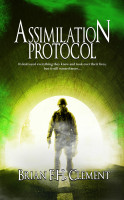Fear the Reaper by David Simms
Macabre Ink, 2018
ISBN-13: 978-1948929790
Available: Paperback, Kindle edition
Fear the Reaper was released in June, and it is frighteningly timely. I read it just after finishing coursework in special education, which included the effects of eugenics on public education, and right at the time that the family separation of immigrants seeking asylum started to receive intense media attention. I have heard many people say “this isn’t the American way”. This is a historical novel grounded solidly in fact, and it hits home that this isn’t the first time the American way has included dehumanizing and forcibly separating “inferior” or “weak” populations.
It’s 1933, and psychologist Sam Taylor, designer of a test that can separate the “feebleminded” from the general population, has been hired to evaluate patients at a sanitarium in rural Virginia that has a solid commitment to practicing eugenics. Eugenics is a philosophy that grew from the conviction that only healthy, able, intelligent, heterosexual, attractive white people should be allowed to contribute to human genetic evolution. Many people not fitting that description, including homosexuals, foreigners, the disabled, mentally ill, and cognitively impaired, and African-Americans, were sterilized(or worse) so they wouldn’t be able to pass on their genes.
The superintendent of the sanitarium, Joseph Dejarnette, was a real person, the sanitarium in the book is very similar to the one he ran, and many of the scenes in the book are based on primary sources. While there is a mild supernatural aspect to this, it’s not the ghost haunting the main character that is horrific– it’s the things people do to each other, or are complicit in. And it’s not that it’s only one person– Dejarnette is just a representative of an entire movement, well-funded by corporate donors, committed to “improving” and “purifying” the human race, that is systematically eliminating anyone who gets in the way. Even knowing a little about the eugenics movement, as I was reading this, I thought “is all of this really real?” It is so outrageous and appalling in places that it’s easy to think that the author got carried away by his topic– it is fiction, after all– but having spoken to him, I can tell you that yes, people really believed and acted this way, dehumanizing the patients and practicing brutal treatments on them.
If you are looking to have your faith in humanity revitalized, this is probably not your best choice. It is a terrifying, eye-opening look at the eugenics movement, and how people become complicit in reinforcing and participating in evil. Simms does an effective job with character development; even brief interactions with minor characters make you feel you know them well enough that when they are caught in the events that occur it’s even more heartbreaking and awful. The ghost didn’t contribute much to the story, nor did the romance (the protagonist is not a likable guy), but the overall sweep of the story carried me past that. It’s an excellent piece of fiction documenting a rarely mentioned part of our history that will creep in, and stay in your mind, long after you finish it.
Editor’s note: David Simms is a personal friend and reviewer for Monster Librarian.







Follow Us!